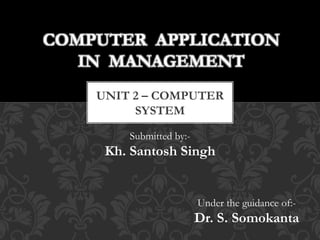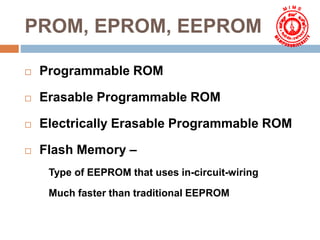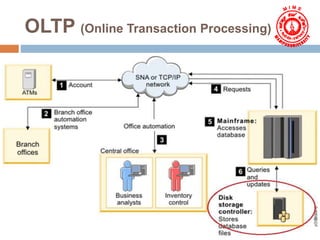Computer system
- 1. COMPUTER APPLICATION IN MANAGEMENT UNIT 2 ĻC COMPUTER SYSTEM Submitted by:- Kh. Santosh Singh Under the guidance of:- Dr. S. Somokanta
- 2. RecapĄ. ? Characteristics of Computer ? Generation of Computers ? Era of Personal Computers ? Digital Computers ? Micro Computers
- 3. RecapĄ. ? Organization of Computers ? Hardware ? Input Devices ? Output Devices ? Software ? System Software ? Application Software
- 10. Memory
- 11. Memory Organisation ? Internal ? External
- 12. Internal Memory ? CPU Memory ? Cache Memory ? Primary / Main Memory
- 13. CPU Memory ? Internal Processor Memory ? Embedded into the processor ? High Speed Register ? Actual Processing
- 14. Main Memory ? Primary Memory ? Communicates directly with the CPU ? 2 types - RAM & ROM ? RAM ĻC Random Access Memory ? ROM ĻC Read Only Memory
- 15. Random Access Memory ? Read-Write-Memory ? Random access of data ? Volatile in nature ? Manufactured with Bipolar or MOS technology ? Types ĻC SRAM, DRAM, SDRAM, RDRAM, DDR SDRAM, FPM DRAM & EDO DRAM * MOS ĻC Metal Oxide Semiconductor
- 16. RAM Types ? SRAM- Static RAM ? DRAM- Dynamic RAM ? SDRAM- Synchronous Dynamic RAM ? RDRAM- Rambus Dynamic RAM ? DDR SDRAM- Double Data Rate SDRAM ? FPM DRAM- Fast Page Mode DRAM ? EDO DRAM- Extended Data Out DRAM
- 17. Read Only Memory ? Non Volatile in nature ? Data / Program not modifiable ? Store BIOS program ? Types ĻC ? Masked ROM ĻC Non user programmable ? PROM, EPROM, EEPROM, Flash Memory ĻC User programmable
- 18. PROM, EPROM, EEPROM ? Programmable ROM ? Erasable Programmable ROM ? Electrically Erasable Programmable ROM ? Flash Memory ĻC Type of EEPROM that uses in-circuit-wiring Much faster than traditional EEPROM
- 19. Cache Memory ? Small & Fast but Expensive ? Placed between CPU and Main memory ? Size ranges from 64KB to 2MB ? Types: ? Primary or Level 1 Cache (on-chip cache) ? Secondary or Level 2 Cache (on-board cache) ? Level 3 Cache (on-board cache)
- 20. External Memory ? Auxiliary Memory / Secondary Storage ? Store larger amount of data / information ? Non Volatile in nature ? Categories: ? Sequential Access Devices ? Direct Access or Random Access Devices
- 21. Magnetic Tape ? Sequentially accessed ? Read / Write with HEAD device ? 2 popular forms: Detachable Reel Magnetic Tapes and Tape Cartridges ? Storage Capacity of a tape = Data Recording Density X Length of the Tape
- 22. Magnetic Disks Track ? Circular plate of metal/plastic Sector ? Coated with magnetized material ? Direct Access Storage ? Rewritable ? Mapping or Formatting ? Low-level formatting ? High-level formatting
- 23. Disk Drive ? A generic term ? A device on which disk is mounted ? Consists of motor, arms assembly with heads ? Speed ranging from 3600 ĻC 7200 RPM ? Information recorded during disk rotation ? Uses : Floppy disk drive Hard disk drive
- 24. Floppy Disk ? Removable storage device ? Out of market ? Size ranges from 100 KB ĻC 200 MB ? 3 ? inch HIFD 1998-99
- 25. Hard Disk ? Invented in the 1950ĄŊs ? Originally called ĄŪFixed DiskĄŊ or ĄŪWinchestersĄŊ ? Storage Capacity = Number of recording surfaces X Number of tracks per surface X Number of sectors per track X Number of bytes per sector ? Internal ? External ? Solid-state-drive(SSD)
- 26. RAID ? Redundant Array of Inexpensive Disks ? Higher storage capacity ? Uses mainly in the Mainframes and Servers
- 27. Optical Disk ? Made of plastic plate with light sensitive recording surface ? Capable of storing vast amount of data ? Single spiral track ? Sectors are of same length ? Use laser beams for Read / Write ? E.g. CD-ROM, WORM Disc, Erasable Optical Disc, DVD-ROM, Blue Ray Disc Storage capacity = No. of Sectors X No. of Bytes per Sector
- 28. Flash Drive ? Also known as ĄŪThumb DriveĄŊ or ĄŪPen DriveĄŊ ? Not actually a drive ĻC no moving parts ? Based on EEPROM technology ? Essential components 1. Standard A USB Plug 2. USB Mass Storage Controller 3. Flash Memory Chip
- 29. OLTP (Online Transaction Processing)
- 30. OLTP (Online Transaction Processing)
- 31. CONCLUSION
- 32. THE END Any Questions ?
































